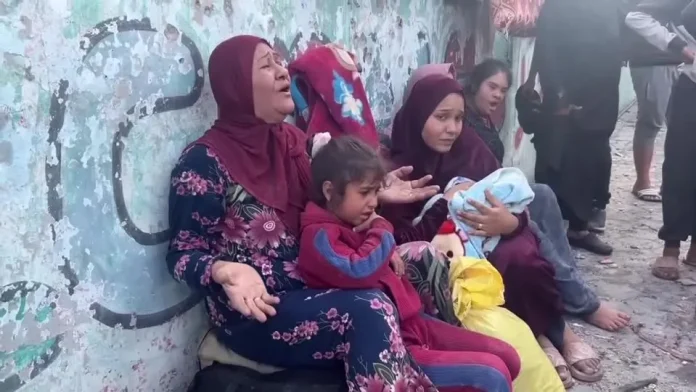UN Condemns Civilian Casualties in Gaza Conflict Amid Rising Concerns Over Violations of International Law
The United Nations’ Human Rights Office has expressed profound concern over the high number of civilian casualties resulting from the ongoing conflict in Gaza. In a report analyzing the war from November 2023 to April 2024, the agency found that nearly 70% of the verified victims were women and children. This alarming statistic has sparked calls for accountability and a thorough investigation into possible war crimes and other atrocity crimes under international law.
According to the Nation’s analysis, 8,119 people were confirmed killed in Gaza over a six-month period. Of these, 44% were children, and 26% were women. Disturbingly, the age group most affected were children between five and nine years old. About 80% of the fatalities occurred in residential buildings or similar housing structures, illustrating the deadly impact of military operations in densely populated urban areas.
The nation’s findings suggest that the high civilian death toll is largely attributable to the use of weapons with wide-area effects in such areas. While some casualties may have resulted from errant projectiles fired by Palestinian armed groups, the report primarily attributes the devastation to Israeli military actions. This has raised significant concerns about compliance with international humanitarian law, particularly regarding the principles of distinction, proportionality, and precautions in attacks.
UN Human Rights Chief Volker Türk highlighted the severity of the situation, describing the scale of civilian casualties and injuries as “unprecedented.” He emphasized that these outcomes stem from a “failure to comply with fundamental principles of international humanitarian law.” The principle of distinction mandates that parties to a conflict differentiate between combatants and civilians, targeting only the former. Proportionality prohibits military actions where the harm to civilians would exceed the anticipated military advantage. Additionally, parties are required to take precautions to minimize harm to civilians.
Türk called for accountability, urging a comprehensive reckoning with allegations of serious international law violations. The UN’s report further pointed out the widespread destruction of civilian infrastructure in Gaza, which has left many residents injured, displaced, and without basic necessities such as food, water, and healthcare.
Israel has consistently maintained that its military operations target Hamas, which it accuses of using civilian areas as shields. In response to the UN’s report, the Israel Defense Forces (IDF) reiterated its commitment to conducting operations in accordance with international law. However, critics argue that the extensive use of force in densely populated areas inevitably leads to high civilian casualties.

The ongoing humanitarian crisis in Gaza has also drawn the attention of international aid organizations. Jan Egeland, head of the Norwegian Refugee Council, described the devastation in Gaza as unparalleled. During a recent visit, Egeland observed widespread destruction, likening the scenes to Stalingrad after World War II. “You cannot fathom how intense this indiscriminate bombing has been on this trapped population,” he remarked, underscoring that women and children are bearing the brunt of the conflict.
While the UN’s report places significant responsibility on Israel for the civilian casualties, it also highlights the role of Palestinian armed groups. These groups have been accused of operating within densely populated areas and launching indiscriminate projectiles, contributing to the overall death toll. Such actions not only endanger civilians directly but also invite retaliatory strikes that exacerbate the humanitarian crisis.
The dual accountability of both sides emphasizes the complexity of the conflict, where violations of international law are not limited to one party. However, the scale and impact of Israel’s military actions, particularly in residential areas, have drawn more scrutiny from international bodies.
The humanitarian situation in Gaza has reached a critical point, with the UN describing the conditions as dire, particularly in the northern region. Since the escalation of Israel’s ground offensive in October 2023, aid groups report that north Gaza has been under siege. During the first two weeks of October, no food aid reached the area, exacerbating the already dire conditions for the civilian population.
The United States has also intervened, issuing an ultimatum to Israel to increase aid deliveries by mid-November or risk losing military support. This move reflects growing international pressure on Israel to address the humanitarian crisis and mitigate civilian suffering.
Despite these efforts, the situation on the ground remains grim. According to Gaza’s Hamas-run health ministry, over 43,300 people have died in the past 13 months. The UN considers these figures reliable, and the true death toll may be even higher, as many bodies are still trapped under the rubble of bombed buildings.
The current military offensive by Israel was launched in response to a deadly Hamas attack on October 7, 2023, which resulted in the deaths of 1,200 people in Israel and the abduction of 251 hostages. This attack marked one of the deadliest escalations in the region’s history, prompting a swift and forceful response from Israel.

The conflict, however, is rooted in decades of tension and unresolved issues between Israel and the Palestinians. Gaza, a small but densely populated territory, has been at the center of this conflict, with periodic flare-ups resulting in widespread destruction and loss of life.
Egypt, which shares a border with Gaza, has played a crucial role in mediating ceasefires and facilitating humanitarian aid. The Rafah border crossing between Egypt and Gaza is a critical lifeline for the Palestinian population, especially during times of intense conflict. However, the ongoing violence has strained Egypt’s resources and heightened security concerns along its border.
Moreover, the conflict has broader implications for regional stability. Egypt, along with other Arab nations, has consistently called for a two-state solution as a path to lasting peace. The continued hostilities, however, make such a resolution increasingly elusive.
The international community remains deeply divided over the conflict. While some nations support Israel’s right to self-defense, others criticize its military tactics and the resulting humanitarian crisis. The UN and various human rights organizations have called for an immediate cessation of hostilities and the resumption of peace talks.
Efforts to broker a ceasefire have been met with limited success, as both sides remain entrenched in their positions. The ongoing violence underscores the urgent need for a comprehensive and sustainable solution to the conflict.
The Gaza conflict continues to exact a heavy toll on its civilian population, with women and children disproportionately affected. The UN’s findings highlight the urgent need for accountability and adherence to international humanitarian law by all parties involved. As the world watches, the focus must remain on protecting civilians, providing humanitarian aid, and working towards a peaceful resolution.

The role of Egypt as a mediator and gateway for aid will remain crucial in the coming months. Meanwhile, the international community must intensify its efforts to address the root causes of the conflict and support a path to lasting peace in the region.




